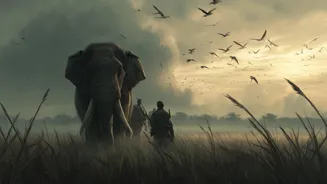What is the story about?
In the timeless tales of Panchatantra, animals are more than mere characters — they are wise lions, foolish frogs, and talkative turtles. These fables, composed in Sanskrit around 200 BCE, have travelled far and wide,
shaping minds across continents. While thePanchatantra is celebrated as one of India’s greatest cultural gifts to the world, it quietly reveals something deeper — the special place wildlife has always held in Indian society.
India is nature’s wonderland, a breathtaking cradle of biodiversity. It is home to about 8 per centg of all known species, including 91,000 types of animals. This richness is not a recent achievement; it is the product of centuries of reverence, protection, challenges, and revival — a story that stretches from sacred
traditions of the past, through colonial devastation, to the scientific conservation efforts of today.
Modern conservation often depends on strict rules and legal frameworks, but ancient India proves that a society can protect wildlife even without extensive policies. In the Vedic period, animals were not viewed as mere resources. They were revered as teachers, protectors and even as deities. Respect for animals translated into their protection and ecosystems flourished naturally.
As time progressed, Indian society became more structured and laws regulating conservation emerged. One of the earliest written references appears in the Arthashastra, authored by Kautilya during the Mauryan era.
The Mauryan period (321–185 BCE) was one of contradictions. Hunting was widespread — a sport for the elite, a royal duty and even a ritual obligation. Yet, there was also a strong emphasis on wildlife protection. The Mauryas imposed fines for harming animals within
protected areas, setting early precedents for regulated conservation.
One of the most notable contributions came from Emperor Ashoka in the third century BCE. Among his famous edicts was the Fifth Pillar, dedicated to the protection of wildlife. It prohibited the killing of certain animals, promoted animal rights and advocated for environmental care. This is considered the first documented conservation law in India.
From the golden periods of Indian history to the
Mughal era, wildlife continued to enjoy a protected status. Pre-colonial India laid the foundation for many modern conservation initiatives. Cultural traditions, scriptures, religious practices and even children’s games highlighted the importance of protecting animals. The land was teeming with birds and wildlife.
The arrival of the British colonisers marked a turning point — and not for the better. Armed with big guns and a hunger for trophies, they hunted relentlessly. Hunting became both a pastime and a status symbol, with
princely states often assisting their colonial allies in the sport.
By the 19th century, wildlife destruction was so severe that laws began to emerge. In 1873, the Madras Elephant Protection Act was introduced, followed by the Wild Birds Protection Act in 1887, which was later revised in 1912 as the Wild Birds and Animal Protection Act. However, this was “selective conservation” — animals valuable to the British, such as elephants used for labour, warfare or generating wealth, were protected, while predators like tigers were exterminated.
The scale of destruction was staggering. In the Madras Presidency — which included present-day Tamil Nadu, parts of Andhra Pradesh, Karnataka, Kerala and Odisha — tigers once roamed freely. The region was even called Puliyar, meaning “Land of the Tigers.” Yet, during the colonial period, every single tiger in the region was wiped out.
Between 1875 and 1925, over 80,000 tigers were killed across India. Leopards suffered a similar fate — within two centuries, the country lost about 90 per
cent of its leopard population. The Indian cheetah fared even worse, being officially declared extinct in 1952.
By the early 20th century, opposition to this destruction began to grow. Activists, journalists and even disillusioned British hunters began advocating for wildlife. Among them was Edward James “Jim” Corbett, born in Nainital, who started as a hunter but later became a staunch naturalist. In 1935, after lobbying from Corbett and others, India’s first protected areas — national parks and sanctuaries — were established.
In 1936, the Himalayan foothills of Uttarakhand became home to Hailey National Park, later renamed Jim Corbett National Park, with a focus on tiger conservation. This was a significant step forward, inspiring conservation-minded citizens who were also part of India’s independence movement.
With independence in 1947, India faced the twin challenges of rebuilding its economy and reviving its wildlife. In the early years, there was no immediate policy framework, but all arms of
government — the legislature, the executive and the judiciary — began contributing.
However, hunting, poaching and wildlife trade continued. Tiger, leopard and snake skins were sold for foreign currency, and modern technology made exploitation even faster.
In the early 1950s, the government introduced the Rhinoceros Preservation Act and the Elephant Preservation Act to protect these flagship species. But it was the late 1960s and 1970s that became the “golden era” of Indian wildlife
conservation.
In 1969, New Delhi officially acknowledged the dire state of wildlife. By 1972, the Wildlife Protection Act was enacted, creating a nationwide framework for protected areas and reserves. It remains the only legislation protecting all wild animals and birds in India, enforced under the Constitution.
Launched in 1973, Project Tiger addressed two concerns: the near-extinction of tigers and the need to preserve the balance of the ecosystem. The idea was simple yet profound — if the apex
predator could be saved, the entire ecological hierarchy could be preserved.
Kailash Sankhala, the project’s first director, championed a radical approach: protecting habitats rather than isolating tigers. By creating human-free zones, tigers could live naturally, and the ecosystem around them would thrive. This philosophy turned the tide for tiger conservation, earning Sankhala the title “Tiger Man of India.”
The 1970s saw the rise of other conservation icons. Jamal Ara, known
as India’s first “Birdwoman,” was a research pioneer who shared her knowledge on All India Radio. SP Shahi, a legendary forest officer, became the first to raise alarms about the state of wolves, earning him the nickname “Wolf Man.”
These dedicated individuals, along with hundreds of others, pushed India toward greater research and smarter conservation techniques.
In 1982, the Wildlife Institute of India was established in Dehradun to boost research. The following year, the
National Wildlife Action Plan was introduced, providing a coordinated roadmap for conservation efforts at both central and state levels.
More than half a century later, India has made tremendous progress, but challenges remain. Mining, agricultural expansion and rapid urbanisation have intensified human-animal conflict. Poaching and illegal wildlife trade, while reduced, have not been eliminated. Sometimes, conservation efforts are hampered by insufficient funds.
In 2017, India updated its National Wildlife Action Plan to run until 2031, with a focus not just on conservation but also community involvement. The fight against climate change, which is damaging ecosystems and destroying habitats, has also become a priority.
The Union Budget 2025–26 allocated Rs 3,412.82 crores for the Ministry of Environment, Forests and Climate Change — a 9 per cent increase from the previous year — demonstrating the government’s financial commitment.
Several ambitious projects have been launched recently:
Project Dolphin (2021) focusses on protecting freshwater and marine dolphins.
Project Cheetah (2022) marks the historic reintroduction of cheetahs to India. Eight were brought from Namibia in 2022, followed by twelve from South Africa in 2023. Most have adapted well, and in 2023, a female gave birth to cubs on Indian soil — the first in 75 years.
Project Tiger has expanded to 54
tiger reserves, making India home to more than 70 per cent of the world’s tiger population. Project Elephant has established 33 reserves, protecting over 60 per cent of the global Asian elephant population.
The Asiatic lion, found only in Gujarat, has made a remarkable recovery — from 411 individuals in 2010 to 674 in 2020.
As of November 2023, India boasts 1,014 protected areas, including 106 national parks, 573 wildlife sanctuaries, 115 conservation reserves, and 220 community reserves,
covering over 175,000 km² — about 5.32 per cent of the country’s land area. This makes India one of the most biodiverse countries in the world.
India’s wildlife journey is one of resilience, deeply woven into the fabric of its cultural identity. From ancient fables to modern science, from colonial exploitation to post-independence revival, it is a story that is both complex and inspiring.
Conservation in India is not just about saving animals — it’s about preserving heritage,
sustaining livelihoods and securing the country’s future.
As India steps into the future, the wise lions, foolish frogs and talkative turtles of the Panchatantra continue to inspire. The call to protect the country’s wildlife has never been stronger — and India’s long, determined fight to safeguard its natural treasures stands as a beacon of hope for the world.
India is nature’s wonderland, a breathtaking cradle of biodiversity. It is home to about 8 per centg of all known species, including 91,000 types of animals. This richness is not a recent achievement; it is the product of centuries of reverence, protection, challenges, and revival — a story that stretches from sacred
Ancient India: Reverence without rules
Modern conservation often depends on strict rules and legal frameworks, but ancient India proves that a society can protect wildlife even without extensive policies. In the Vedic period, animals were not viewed as mere resources. They were revered as teachers, protectors and even as deities. Respect for animals translated into their protection and ecosystems flourished naturally.
As time progressed, Indian society became more structured and laws regulating conservation emerged. One of the earliest written references appears in the Arthashastra, authored by Kautilya during the Mauryan era.
The Mauryan era: A paradox of hunting and protection
The Mauryan period (321–185 BCE) was one of contradictions. Hunting was widespread — a sport for the elite, a royal duty and even a ritual obligation. Yet, there was also a strong emphasis on wildlife protection. The Mauryas imposed fines for harming animals within
One of the most notable contributions came from Emperor Ashoka in the third century BCE. Among his famous edicts was the Fifth Pillar, dedicated to the protection of wildlife. It prohibited the killing of certain animals, promoted animal rights and advocated for environmental care. This is considered the first documented conservation law in India.
Pre-colonial India: A natural sanctuary
From the golden periods of Indian history to the
The arrival of the British colonisers marked a turning point — and not for the better. Armed with big guns and a hunger for trophies, they hunted relentlessly. Hunting became both a pastime and a status symbol, with
By the 19th century, wildlife destruction was so severe that laws began to emerge. In 1873, the Madras Elephant Protection Act was introduced, followed by the Wild Birds Protection Act in 1887, which was later revised in 1912 as the Wild Birds and Animal Protection Act. However, this was “selective conservation” — animals valuable to the British, such as elephants used for labour, warfare or generating wealth, were protected, while predators like tigers were exterminated.
The tiger massacre
The scale of destruction was staggering. In the Madras Presidency — which included present-day Tamil Nadu, parts of Andhra Pradesh, Karnataka, Kerala and Odisha — tigers once roamed freely. The region was even called Puliyar, meaning “Land of the Tigers.” Yet, during the colonial period, every single tiger in the region was wiped out.
Between 1875 and 1925, over 80,000 tigers were killed across India. Leopards suffered a similar fate — within two centuries, the country lost about 90 per
Seeds of resistance
By the early 20th century, opposition to this destruction began to grow. Activists, journalists and even disillusioned British hunters began advocating for wildlife. Among them was Edward James “Jim” Corbett, born in Nainital, who started as a hunter but later became a staunch naturalist. In 1935, after lobbying from Corbett and others, India’s first protected areas — national parks and sanctuaries — were established.
In 1936, the Himalayan foothills of Uttarakhand became home to Hailey National Park, later renamed Jim Corbett National Park, with a focus on tiger conservation. This was a significant step forward, inspiring conservation-minded citizens who were also part of India’s independence movement.
Post-Independence: A new beginning
With independence in 1947, India faced the twin challenges of rebuilding its economy and reviving its wildlife. In the early years, there was no immediate policy framework, but all arms of
However, hunting, poaching and wildlife trade continued. Tiger, leopard and snake skins were sold for foreign currency, and modern technology made exploitation even faster.
First conservation laws of independent India
In the early 1950s, the government introduced the Rhinoceros Preservation Act and the Elephant Preservation Act to protect these flagship species. But it was the late 1960s and 1970s that became the “golden era” of Indian wildlife
In 1969, New Delhi officially acknowledged the dire state of wildlife. By 1972, the Wildlife Protection Act was enacted, creating a nationwide framework for protected areas and reserves. It remains the only legislation protecting all wild animals and birds in India, enforced under the Constitution.
Project Tiger: A turning point
Launched in 1973, Project Tiger addressed two concerns: the near-extinction of tigers and the need to preserve the balance of the ecosystem. The idea was simple yet profound — if the apex
Kailash Sankhala, the project’s first director, championed a radical approach: protecting habitats rather than isolating tigers. By creating human-free zones, tigers could live naturally, and the ecosystem around them would thrive. This philosophy turned the tide for tiger conservation, earning Sankhala the title “Tiger Man of India.”
Other champions of the 1970s
The 1970s saw the rise of other conservation icons. Jamal Ara, known
These dedicated individuals, along with hundreds of others, pushed India toward greater research and smarter conservation techniques.
Building the scientific framework
In 1982, the Wildlife Institute of India was established in Dehradun to boost research. The following year, the
More than half a century later, India has made tremendous progress, but challenges remain. Mining, agricultural expansion and rapid urbanisation have intensified human-animal conflict. Poaching and illegal wildlife trade, while reduced, have not been eliminated. Sometimes, conservation efforts are hampered by insufficient funds.
Renewed efforts and modern projects
In 2017, India updated its National Wildlife Action Plan to run until 2031, with a focus not just on conservation but also community involvement. The fight against climate change, which is damaging ecosystems and destroying habitats, has also become a priority.
The Union Budget 2025–26 allocated Rs 3,412.82 crores for the Ministry of Environment, Forests and Climate Change — a 9 per cent increase from the previous year — demonstrating the government’s financial commitment.
Landmark projects of the 21st century
Several ambitious projects have been launched recently:
Project Dolphin (2021) focusses on protecting freshwater and marine dolphins.
Project Cheetah (2022) marks the historic reintroduction of cheetahs to India. Eight were brought from Namibia in 2022, followed by twelve from South Africa in 2023. Most have adapted well, and in 2023, a female gave birth to cubs on Indian soil — the first in 75 years.
Expanding flagship initiatives
Project Tiger has expanded to 54
The Asiatic lion, found only in Gujarat, has made a remarkable recovery — from 411 individuals in 2010 to 674 in 2020.
A network of protected areas
As of November 2023, India boasts 1,014 protected areas, including 106 national parks, 573 wildlife sanctuaries, 115 conservation reserves, and 220 community reserves,
More than just saving animals
India’s wildlife journey is one of resilience, deeply woven into the fabric of its cultural identity. From ancient fables to modern science, from colonial exploitation to post-independence revival, it is a story that is both complex and inspiring.
Conservation in India is not just about saving animals — it’s about preserving heritage,
Call of the wild
As India steps into the future, the wise lions, foolish frogs and talkative turtles of the Panchatantra continue to inspire. The call to protect the country’s wildlife has never been stronger — and India’s long, determined fight to safeguard its natural treasures stands as a beacon of hope for the world.
Do you find this article useful?














